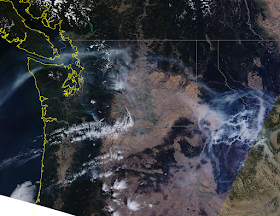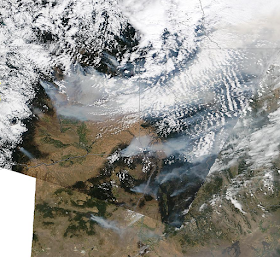Let's take a closer look at how our current situation compares to 2012 and 2015. We will examine visibility as a correlation to smoke "thickness" and look at visible satellite images to determine the extent or volume of smoke.
Visibility: For the thickness of the smoke, let's look at visibility sensors at a few airports in central and eastern Washington. Airports measure visibility because horizontal visibility is extremely important for pilots and air traffic controllers. These sensors measure the horizontal visibility in miles. On most summer days, the horizontal visibility in the Inland Northwest is well over 10 miles. On clear days, mountain ranges 30 to 50 miles away are very easy to see. Visibility reductions to 6 miles are somewhat rare during the summer months and are usually caused by smoke or wind-blown dust. In the summer, visibility reductions to 2 miles or less (without precipitation present) are very rare, and are usually limited to locations in the immediate vicinity of a wildfire.
For this blog, we are going to use visibility restrictions to 2 miles as a benchmark for being a "Bad Smoke Day". The picture below is an example of of 2 miles visibility.
2012 Versus 2017: Wenatchee
The summer of 2012 featured the "September of Smoke" in Wenatchee, WA. An extended period of dry weather with light winds allowed smoke to flood the Wenatchee and Columbia River Valleys during most of September and parts of October. The smoke largely came from several fires that comprised the Wenatchee Complex south and west of Wenatchee. The worst stretch of smoke occurred from the evening of September 12th through September 23rd. For 12 consecutive days, the visibility at the Wenatchee Airport was 2 miles or less for many hours each day. There were some short windows of improved visibility during those 12 days, but there were very few observations during this stretch when the visibility improved to 5 miles.
How does the summer of 2012 in Wenatchee compare to this summer so far? Check out this graph. Keep in mind that the worst smoke in 2012 occurred from mid to late September, and we are only one week into September 2017. Smoke or haze was occasionally reported at the Wenatchee Airport into late October.
 |
| September 19, 2012: A plume of wildfire smoke can be seen streaking across central Washington from the Wenatchee Complex. |
 |
| September 6, 2017: This visible satellite images shows thick smoke over the entire Pacific Northwest. |
2015 Versus 2017: Spokane
The August 21st "Smoke Storm" in 2015 produced a wall of thick smoke that invaded the Spokane Metro area. The visibility in the city rapidly decreased from over 10 miles in morning to less than 2 miles in the mid afternoon into the evening hours. The smoke originated from several fires in central and northeast Washington including the Wolverine Fire (Lake Chelan), the Okanogan Complex (near Omak), and the Carpenter Rd Fire (Hunters WA). Northwest winds of 15 to 20 mph behind a cold front were responsible for directing the wall of smoke into Spokane. Check out the visible satellite image below. Look how the northwest winds funneled smoke from 3 large fires into the metro.Was the 2015 "Smoke Storm" an isolated occurrence of smoke that summer? It was not. The summer of 2015 had 31 days with visibility reductions of 6 miles or less due to smoke or haze. The summer of 2015 set records for the number of acres burned in the state of Washington with large fires in Chelan, Okanogan, Ferry, and Stevens Counties. With all of the fires, smoke and haze was common in Spokane as early as June in 2015.
2015 vs 2017 Conclusion: In comparing the 2015 "Smoke Storm" to our "Labor Day 2017" smoke event, 2017 has easily had the bigger impact. Not only have we experienced a lower visibility with our influx of smoke in 2017 (1 mile visibility versus 1.25 miles), but the duration of smoke has been much greater. Spokane has been going on 4 days of visibility at or below 2 miles in this ongoing smoke event. The 2015 "Smoke Storm" only produced 6 hours. Will the 2017 season equal the number of smoke days (6 miles or less) in 2015? Let's hope not.
Outlook: Increasing west winds on Saturday (Sep 9) should help clear some of our smoke from the Inland Northwest. However, widespread rains are not expected anytime soon. Without decent rains, smoke will likely return. The wildfires of 2017 have certainly surpassed 2012 and 2015 for flooding the Pacific Northwest with a volume of thick (less than 2 mile visibility) smoke. We will see if the smoke will linger well into September or October to rival the summers of 2012 or 2015 for total number of smoke days.





No comments:
Post a Comment